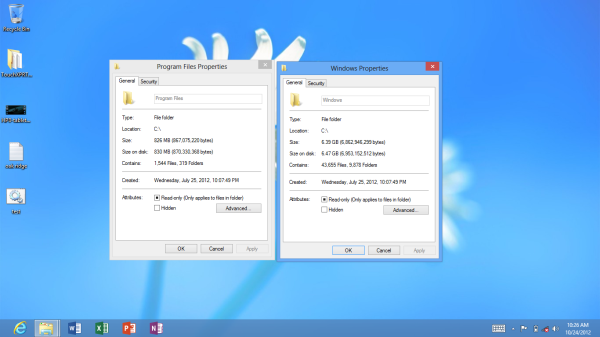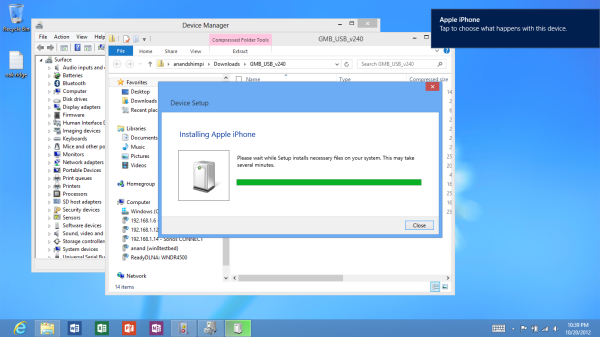The Windows RT Review
by Vivek Gowri & Anand Lal Shimpi on October 25, 2012 12:00 PM EST- Posted in
- Windows RT
- Operating Systems
- Microsoft
- Mobile
- Windows 8
- Tablets
UI Performance, Storage, and USB Compatibility
by Vivek Gowri and Anand Shimpi
With Windows Phone 7, Microsoft did a great job of taking generation-old hardware and delivering a great user experience in spite of any silicon-level deficiencies. So naturally, with the new Windows UI, we were expecting a very smooth UI regardless of the underlying hardware. And they’ve most certainly delivered on that.
Animation frame rates are consistently good all the way through the UI, easily delivering what appears to be 60 fps for UI transitions. When pushed, Modern UI seems more likely to completely drop animations versus dropping frames, which eliminates the choppy experience you sometimes find in Android. It isn’t a common occurrence, the experience is generally very fluid. This kind of consistently smooth UI is what Google has been striving for in every recent release of Android, dedicating the release of 4.1 to eliminate the dropping of frames in even basic interactions. Scrolling, swiping, snapping, app switching - it doesn’t really matter what you’re doing, RT is just really smooth. Combined with the fluidity of the gestures, the entire system just feels like liquid, there are just no real slowdowns even running on a no-longer impressive SoC like Tegra 3.
| Application Launch Time Comparison | |||||||
| Boot | Web Browser | Maps | Games Center / Xbox | ||||
| Apple iPad (3rd gen) | 32.0s | 1.0s | 2.4s | 1.1s | 1.9s | ||
| Microsoft Surface | 27.7s | 2.6s | 7.1s | 5.0s | 5.0s | ||
But there is one area that RT struggles in, and it’s something that was an issue in Windows Phone 7 too - application launch times. Anand included this table in his Surface review, and it shows that boot performance is decent, but the 3rd generation iPad just kills it in application loading. The new A6X-infused 4th gen iPad probably widens that gap too, so it’s a pretty stark difference. It’s something that Microsoft needs to really focus on when updating the OS, because it’s easily one of the most glaring flaws in an otherwise stellar interface.
From a storage standpoint, the OS takes up between 6.5 and 7.5GB of space (Anand measured 6.47GB on Surface, I measured 7.35GB on the VivoTab RT) and Office takes up another 750-850MB (830MB for Surface, 749MB for the ASUS), so you’re looking at 7.5-8GB of NAND dedicated to the OS. On my 32GB VivoTab RT, I had 25.3GB of storage to start with, so after Windows and Office, I was looking at 17GB left over for programs and documents. That’s....not a lot - a bit of music, a decent selection of applications, a couple of videos, and pretty soon I’m looking at less than 10GB of storage left over. Thankfully, we’re seeing microSD slots on a lot of the more prominent Windows RT slates, so if you run out of room, you could theoretically toss in a 32GB or 64GB microSDXC card. Depending on how much data you plan on storing, I think you can get away with the lesser internal NAND and some microSD cards.
It’s also pretty clear that there will not be a Windows RT slate shipped with less than 32GB of onboard NAND. If you’re holding out for a cheaper Windows RT device with less storage, like a 16GB tablet for $399, there’s almost no way that happens - it’s implausible to think that anyone would ship a tablet with less than 5GB of space left for data storage.
Another key detail in Windows RT is wide-ranging USB peripheral support. USB ports have been a common feature on 10” Android tablets, but device support was typically limited to flash drives and basic input devices. The goal with Windows RT was to bring the traditional Windows experience to tablets, so USB driver support is pretty important. It’s not as easy as on an x86 system, where most USB peripherals would just work, but even with more limited Windows-on-ARM drivers, it’s pretty decent overall.
USB drives obviously work as you’d expect them to. Even SATA to USB adapters worked fine when plugged into Surface. Other smartphones and tablets also worked, although their level of support varied. For example, you can plug in the iPhone 5 and have it come up as a supported device for moving pictures to/from. However USB tethering is not supported by the class driver included in Windows RT. You can even plug an iPad into Surface and get the same level of support. The few Android phones I tried to connect in MTP all worked as expected, though transfer rates off my Optimus 4X HD seemed on the slow side, likely a function of the phone’s internal eMMC.
Printer support is pretty decent, although the Epson Workforce 910 Anand tried didn’t actually have specific driver support under RT. Although development for the desktop side of Windows is limited, manufacturers can supply Windows RT drivers to enable support for some more obscure devices. Unfortunately when it comes to those devices you’ll have to play the waiting game as there’s simply not a lot of third party Windows RT drivers available for download today.












233 Comments
View All Comments
N4g4rok - Thursday, October 25, 2012 - link
That's a question that can be answered when more viruses are being written for ARM platforms. As it stands now, virus's we see on regular x86 machine really won't be able to execute on ARM platforms.glynor - Thursday, October 25, 2012 - link
All software for Windows RT must come from the Windows Store.This is EXACTLY like Apple and the iOS App Store. Therefore, unless Microsoft approves viruses and distributes them intentionally, it should be a non-issue.
arcanetribe - Thursday, October 25, 2012 - link
Even iOS has had a few leaks in the ship. Remember when you could jailbreak an iOS device by visiting a website in Safari? (jailbreakme.com)I'm just wondering if some of the legacy of X86/AMD 64 Windows will make Windows 8 RT inherently less secure than an iOS device.
But, as N4g4rok says above, I guess only time will tell.
I'd still like to see an article that specifically addresses the strengths and weaknesses of Windows 8 RT. If that article exists, please point me to it. I've looked!
karasaj - Thursday, October 25, 2012 - link
Does anybody think it's realistic to get something like Chrome or Firefox into the windows app store? I like IE10 but (like Anand/Vivek) have always been a chrome guy. The ability to just "click" a tab to switch is really valuable for 10+ tabs open. Anybody share hopes for chrome or firefox to be developed for RT?Also: did you all notice any slowdowns when having like 10+ tabs open, or did you try it out ever?
faizoff - Thursday, October 25, 2012 - link
I know there is a Chrome install for the Modern UI in the regular windows 8. That works great since I can use adblock and certain script blockers. I did see Google search in the store so it may only be a matter of time before Chrome shows up there for RT devices as well.bostonraja - Thursday, October 25, 2012 - link
Does anyone here with a Surface RT tried using xfinity comcast online? I was just wondering if flash websites like xfinity or www.cricvid.com work on the RT tablets?Please let me know.
Spivonious - Thursday, October 25, 2012 - link
MS has a built-in Flash that's enabled for certain white-listed sites. I imagine Comcast is in that list, but I don't have an RT tablet to try it out on.daboochmeister - Thursday, October 25, 2012 - link
I don't understand ... what is the missing 6.7GB used for? There'd be a little bit of loss for file tables and such, but nowhere NEAR the 20% that indicates.VivekGowri - Thursday, October 25, 2012 - link
Factor in 7-8% for formatting loss, the rest I assumed was some sort of hidden recovery/restore partition with the factory image.andrewaggb - Thursday, October 25, 2012 - link
What about swap file and hibernate file? I imagine they have a swap file.Probably no need for hibernate on these devices with the low power sleep states.